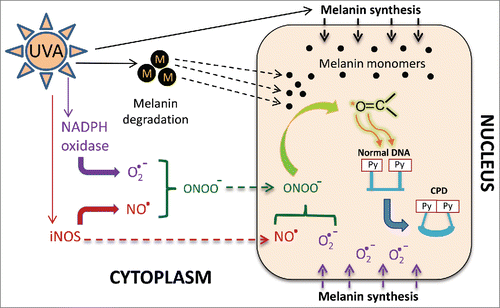Figures & data
Figure 1. Putative role of melanin in the generation of dark CPDs. Ultraviolet (UV) exposure induces melanin synthesis, during which melanin monomers accumulate along the nuclear membrane. Direct UV exposure of melanin in melanosomes (“M”, black circles) breaks down the melanin into monomers (small black circles). The melanin monomers are lipophilic and can cross the nuclear membrane (broken black arrows). Melanin synthesis also produces superoxide (O2·−) which, owing to its close proximity to the nuclear membrane, can presumably cross into the nucleus (purple broken arrows). UV exposure also induces the production of superoxide anions and nitric oxide (NO·) radicals by respectively activating NADPH oxidase and iNOS enzymes. Superoxide and nitric oxide combine with each other to make peroxynitrite (ONOO−). Both nitric oxide and peroxynitrite can diffuse intracellularly or across the cell membrane. Superoxide and nitric oxide can also generate peroxynitrite in the nucleus, where it reacts with melanin monomers to produce melanin carbonyls (C=O, highlighted in green) in excited triplet states. An excited triplet carbonyl transfers its energy to a DNA dipyrimidine (Py), creating a cyclobutane pyrimidine dimer (CPD).

